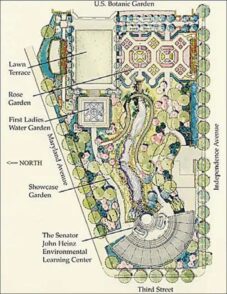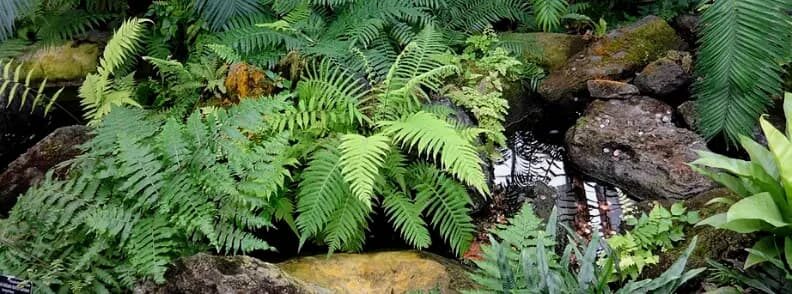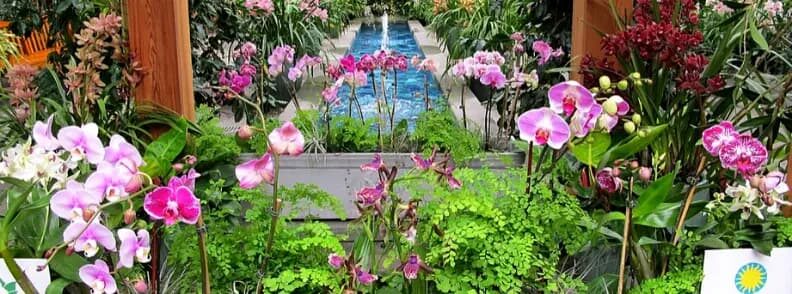The US Botanic Garden is located in Washington, DC. In addition to its magnificent gardens, the United States Botanic Garden also has a rich history.
The idea of a National Garden dates back to the days of George Washington and Thomas Jefferson.
Visit US Botanic Garden Guide
However, the US Botanic Garden (USBG) dates back to 1816, when the Columbian Institute for the Promotion of the Arts and Sciences formally proposed the idea. Congress established the Columbian Institute Garden in 1820, just west of the United States Capitol Grounds, where it operated until 1837.
The garden proposal was then revived in 1842 after the Wilkes Expedition brought a collection of living plants back to the US from around the world. Eight years later, after being housed in temporary greenhouses, the plants were finally moved to the site of the previous institute’s garden.
Finally, in 1933, the US Botanic Garden moved to its current location in Washington DC. Today you will find there the Conservatory with two acres of outdoor grounds and Lord Burnham greenhouses, the Frederic Auguste Bartholdi Park, the Administration Building, and the National Garden. The latter opened in the autumn of 2006 and added three additional acres to the U S Botanic Garden Complex.
The United States Botanic Garden is one of the oldest botanic gardens on the continent. It’s also the oldest continuously operated botanical garden in the country.
What to see when you visit the US Botanic Garden
Well, first of all, there’s the Plant Collection at the Botanic Garden Conservatory, a fascinating museum with a total of about 26,000 different living plants, all of which are used for the exhibition space, study and/or exchange with other institutions. To name just a few, you’re going to see economic trees, medicinal plants, uncommon and endangered species, orchids, cacti and succulents, cycads, and ferns.
The palm-house structure called The Jungle has a walkway for tourists 24 feet above the ground.
There are also various rotating exhibits as well as exhibits that come and go. So before your visit or when you get there check them out. To avoid missing an interesting visit, check out what’s in bloom on the US Botanic Garden website.
Outdoors, you can walk through Bartholdi Park, one of the favorite gardens of many Washingtonians. Established in 1932, it was named after the man who designed the historic Fountain of Light and Water in its center, Frederic Auguste Bartholdi. The famous Bartholdi Fountain is surprisingly graceful, given its mammoth size – it weighs about 15 tons and is 30 feet tall.

The geometrically arranged flower beds in the Bartholdi Park are constantly updated to reflect trends in American gardening. In addition to being a lovely place to walk around, the Park also serves as a home landscape demonstration garden, featuring innovative plant combinations with a variety of styles, designs, and themes.
The National Garden is the latest addition to the US Botanic Garden. On its three acres, you’ll find the:
- Regional Garden with native Mid-Atlantic plants
- Rose Garden with organically grown roses
- Butterfly Garden which shows how flowers are vital to pollinators
- First Ladies Water Garden, honoring the contributions of United States First Ladies
- Lawn Terrace where outdoor events and summer classes take place
- Amphitheater where educational programs take place outdoor

Is the US Botanic Garden free?
Admission to all areas of the US Botanic Garden is free of charge.
- The Conservatory is open daily between 10.00 and 17.00
- The National Garden is open daily between 07.90 and 17.00
- Bartholdi Park is open every day from dawn to dusk.
Handheld still or video cameras can be used all the time. However, if you want to use a tripod or draw with an easel or use solvent-containing art supplies, you will need a permit.
You’ll find a limited number of parking spaces within walking distance of the US Botanic Garden, so public transport is your best bet. Luckily, both Metrorail and Metro busses have lines that go straight to the US Botanic Garden. The site is also completely accessible and offers parking for guests with limited mobility.
The Garden’s outstanding collections are arranged in fascinating displays that provide not only an educational experience but also an opportunity to relax and take in the beauty of nature.
The US Botanic Garden has plant exhibitions and flower shows throughout the year. Each visit offers locals and travelers a wide range of ideas on creative garden design, up-to-date tips on gardening, and botanical knowledge.
Too difficult to visit the US Botanic Garden with your friends these days?
Go on a virtual tour for some armchair travel right now!
Featured image DC Gardens / CC BY 2.0
About the author

Mirela Letailleur is a Romanian travel blogger living in the South of France. She writes on The Travel Bunny travel blog about affordable travel in Europe, creator of unique free travel guides, local travel expert. Problem solver. Wannabe coffee guru.
You should also read these travel articles on The Travel Bunny blog
Summer travel tips: 20+ ideas for a better vacation
Gardens and parks in Rome
Athens important buildings and parks

